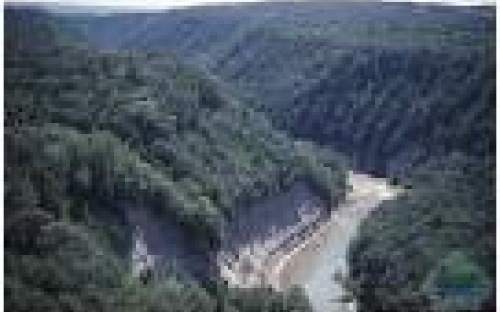The History of Cattaraugus County by Everts 1879 describes the Valley of Zoar as containing from 800 to 1000 acres of bottom lands, situated along both sides of Cattaraugus Creek, and in the southwest part of the Town of Collins [in Erie County], the northeast part of the Town of Otto, and the northwest corner of East Otto. Settlers were attracted to the fertile land and followed Indian trails to the area or the water to the area. In the early 1800s the land was deeded to the Holland Land Company. The land was surveyed and sold during the 1820s. Many settlers came into Cattaraugus County through the Zoar Valley area.
Samuel Hill a native of New Hampshire immigrated to the Valley of Zoar coming down the Cattaraugus Creek in a canoe with his family consisting of his wife and three sons and two daughters. They arrived April 12, 1814 and found three other families living there. A Mr. Orr had built a log home that he left and moved to the other side of the creek where he settled and married Hope Pratt. The Hill family moved into the abandoned log home and bought one hundred acres. In 1815 Mr. Hill bought a farm on the north side of the creek, in the town of Collins and built a log tavern. Cattaraugus Creek now runs over the spot where the building once stood. The floor of the tavern was made of black walnut, between two and three feet wide one side was faced with a broad-axe. Potatoes, bear meat, venison and johnny-cake were the principal foods.that wre served at the inn. The day after opening the tavern, nine land lookers stopped and spent the night sleeping on the floor. For thirty years Mr. Hill offered food, entertainment and a place to rest for man and beast.
Many other pioneers followed the Hills throught the Zoar Valley region. The New York State Department of Environmental Conservation website states that historic records from 1842 reveal that farming was practiced along both sides of the creek near what is now Forty Road. At the intersection of Forty and Wickham Roads a cheese factory was located. At least two sawmills were located in the area. Oil and gas wells were drilled in the area in the 1890s. One of the abandoned wells was recently plugged.
In about 1865, the Atlantic and Great Western railroad was planned to cross Zoar Valley near the North Otto Road. The approaches to the bridge were built and most of the grade work was done up to Collins Center before the project was abandoned. Small parts of the grade still remain.
Elisha Derby purchased the current “Valentine Flats” area along Cattaraugus Creek from the Holland Land Company in 1837. The maps show his house located just below Overlook Point. In 1900 Ernest and Caroline Valentine purchased the land and the area was then known as “Valentine Flats”. In 1926 the Niagara Lockport and Ontario Power Company purchased land from the flats and downstream to Overlook Point to build a hydroelectric power dam. Tests borings were made to determine if the rock would hold a dam. The brittle shale made building a dam impractical. Valentines remained on the farm as tenants for some time. Once the house was empty the land was rented to bean growers. In 1952, Mr. Herbert Darling, purchased land including the Valentine Flats area from the Niagara Mohawk Power Corporation, te successor to Niagara, Lockport and Ontario Power Company. Herbert Darling gifted 1,425 acres to the State of New York in 1961 and 1962. That was the beginning of New York State ownership and stewardship of the Valentine Flats area.
Zoar Valley is presently preserved for public use. The Zoar Valley Multiple Use Area (MUA) encompasses more than 2,939 acres. The Zoar Valley MUA is composed of three parcels of land including an area located along the Cattaraugus Creek Gorge, a 5 acre Cattaraugus Creek Waterway Access, and a 387 acre detached parcel. Approximately 1,912 acres of the Zoar Valley MUA are located in Cattaraugus County; the remaining 1,011 acres span into Erie County. The Department of Environmental Conservation describes it as “one of the most scenic, ecologically diverse and potentially sensitive environmental areas in Western New York...Zoar Valley is known for the spectacular scenery created by its deep gorge, sheer cliffs, flowing waterfalls and dense forests”. Please visit this website to learn more: http://www.dec.ny.gov/lands/36931.html
Submitted by Sue Cross Town of Mansfield Historian 2013

